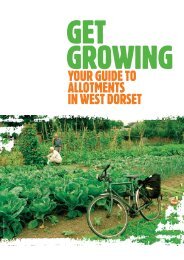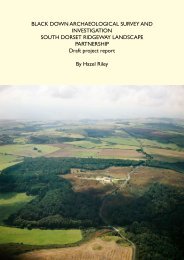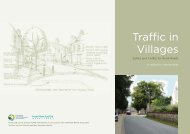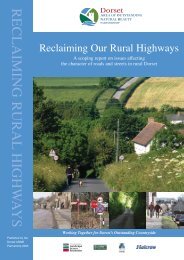Woodland Strategy 11.34 Mb - the Dorset AONB
Woodland Strategy 11.34 Mb - the Dorset AONB
Woodland Strategy 11.34 Mb - the Dorset AONB
Create successful ePaper yourself
Turn your PDF publications into a flip-book with our unique Google optimized e-Paper software.
<strong>Dorset</strong>’s Trees,<br />
Woods and Forests<br />
Section 3<br />
13<br />
Why Trees, Woods and Forests are important<br />
Trees, woods and forests and <strong>the</strong>ir associated benefits<br />
(biodiversity, woodfuel, timber for construction, social<br />
wellbeing, etc) have <strong>the</strong> ability to contribute to <strong>the</strong><br />
improvement of 21 of <strong>the</strong> Quality of Life indicators for<br />
<strong>the</strong> South West and 39 of <strong>the</strong> 68 UK national indicators<br />
including protecting natural resources and creating<br />
sustainable communities (Willis 2004). In addition, <strong>the</strong><br />
area of woodland in <strong>the</strong> UK, <strong>the</strong> protection and<br />
expansion of ancient and semi-natural woodland and<br />
<strong>the</strong> sustainable management of woodland are national<br />
indicators in <strong>the</strong>ir own right. <strong>Woodland</strong>s, particularly<br />
ancient woodlands are significant archaeological<br />
remains and should be conserved as such. <strong>Woodland</strong><br />
can be a major contributor not only to UK sustainable<br />
development policy but also to policies on health,<br />
Yellow Archangel © David Rees<br />
education, social inclusion, rural development and<br />
biodiversity. The <strong>Woodland</strong> Trust and National Forest objectives highlight <strong>the</strong> demand for<br />
new woodlands to deliver environmental and socio-economic benefits.<br />
Examples of how trees, woods and forests can contribute include:<br />
• Biodiversity – woodlands, forests and trees provide habitats for a great variety of animal<br />
and plant species, many of which would not survive without <strong>the</strong>m. In particular, ancient<br />
woodlands are enormously important as <strong>the</strong> plants and animal species have evolved and<br />
developed with continuous woodland cover or traditional woodland practices such<br />
as coppicing.<br />
• Landscape – trees and woodlands form an important component of <strong>the</strong> landscape.<br />
Wooded landscapes, such as <strong>the</strong> Marshwood Vale, ei<strong>the</strong>r directly or indirectly contribute<br />
to our quality of life. They help give landscapes a sense of place, identity, quality and<br />
security which in turn promotes enjoyment, access and economic return.<br />
• Climate Change Mitigation – forests and woodlands play a vital role in <strong>the</strong> absorption of<br />
carbon emissions. The amount of carbon sequestered is dependent on <strong>the</strong>ir management<br />
and wood can be used as a carbon-lean energy source. Tree species, thinning, productivity<br />
and yield class are all factors that need to be considered in <strong>the</strong> future. Woodfuel is a<br />
growing market in <strong>Dorset</strong>.<br />
• Economics – forests and woodlands contribute to <strong>the</strong> strength of local, regional and<br />
national economies in many different ways. Directly this is achieved through timber<br />
production and processing, employment opportunities, local products, rural development,<br />
and land regeneration; indirectly through landscape benefits which attract tourist revenue<br />
and local visitors. Declining income from broadleaved woodlands over <strong>the</strong> last 20 years<br />
has resulted in a massive reduction in resources available for work in woodlands of all<br />
kinds. However, forestry is one of a few industries based on renewable resources, and has<br />
a vital future role in a more sustainable, low-carbon economy.<br />
• Access & Recreation – woodlands and forests are some of <strong>the</strong> most popular visitor<br />
destinations in <strong>the</strong> UK. Activities such as walking, cycling and riding can provide health<br />
benefits as well as enjoying a sense of tranquillity and well being to local populations.<br />
Woods and forests are increasingly being managed for a wide range of activities such as<br />
shooting, mountain biking, walking and wildlife watching, creating revenue for<br />
landowners and associated businesses.<br />
• Education – <strong>the</strong> woodland environment provides an ideal opportunity to learn about <strong>the</strong><br />
relationship between humans and <strong>the</strong> natural environment, and can offer all manner of<br />
cross-curricular learning opportunities. This helps develop an awareness of <strong>the</strong> rural<br />
environment and links between rural and urban environs. The development of forest<br />
schools has been a successful way of increasing education opportunities and contributing<br />
to education enabling us to appreciate our heritage and culture and live a healthier life.<br />
<strong>Dorset</strong> currently has no accredited Forest School<br />
• Communities and Places – trees, woods and forests can provide a wide range of benefits<br />
to all sections of <strong>the</strong> community. They reduce noise and air pollution and provide<br />
sustainable urban drainage and shade. They create a green infrastructure, provide a sense<br />
of ‘well-being’, inspire people, improve neighbourhoods and bring people of different<br />
cultures, generations, backgrounds and religions toge<strong>the</strong>r for a common goal or purpose.<br />
• Water Quality – In many instances woods and forests can improve water quality and<br />
reduce <strong>the</strong> potential for flooding. Trees can stabilise slopes and riverside banks and<br />
strategically located woodlands can protect water from diffuse pollution from<br />
agriculture and nutrient run-off. <strong>Woodland</strong> on floodplains also has <strong>the</strong> potential to<br />
physically ‘retain’ water in times of heavy rainfall, reducing peak flows.<br />
• Cultural and Historical Heritage – <strong>the</strong> trees, woods and forest we see today are <strong>the</strong><br />
product of historic land management systems. Evidence suggests that humans were<br />
managing woodlands in <strong>the</strong> Mesolithic period. This continued management incorporated<br />
open space creation, coppicing, pollarding and cultivating fruit in orchards. It has given a<br />
unique identity to <strong>the</strong> cultural and historic landscape of <strong>Dorset</strong>.












